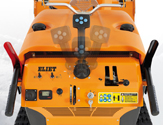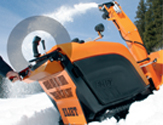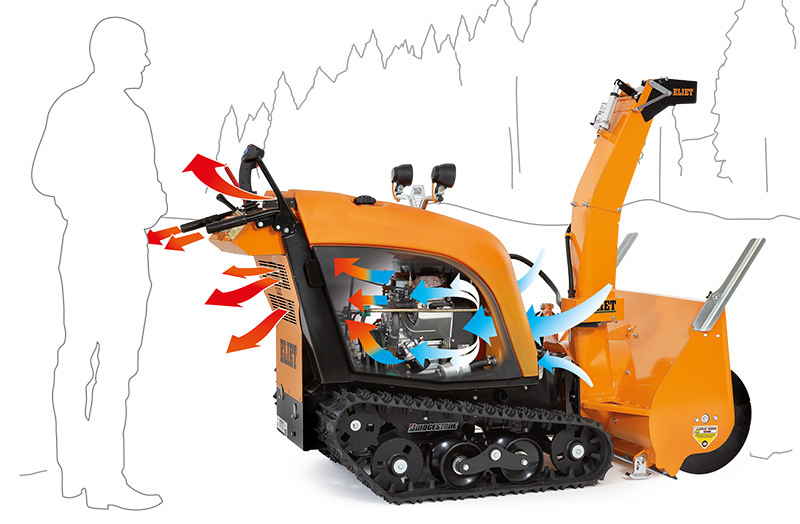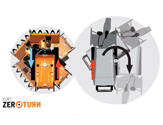This website uses cookies to improve your user experience. By continuing to surf, you agree with our Cookie and Privacy Policy. Accept
Snowbob 9018T

Eliet all-in-one™ joystick
For the first time ever on the market, ELIET introduces the multi-function joystick control. This is a centrally positioned joystick encompassing 5 essential functions for operating a snow blower:
1. Determination of the driving speed of the machine
2. Steering of the snow blower
3. Adjusting the discharge chute’s orientation (left – right)
4. Control of the defl ector flaps (upwards– downwards)
5. Lifting the snow clearing head
1. DETERMINATION OF THE DRIVING SPEED OF THE MACHINE
The double hydrostatic pump allows the operator to control the proportional speed of the Snowbob, both forwards and backwards, by simply moving the All-In-OneTM Joystick forward or backwards.
2. STEERING OF THE SNOW BLOWER
The joystick can also be moved sideways for separate drive on the caterpillars: pushing it to the left will increase the drive on the right hand caterpillar, and the machine will make a proportional turn to the left. Similarly, a push to the right will make the machine turn to the right.

Eliet cruise control™
The Snowbob 9018 T is extremely easy to use and can also be set to accommodate the operator’s specific requirements. To set the snow blower’s driving speed, the operator moves the central All-In-OneTM joystick and maintains it in a given position. Some operators prefer to inhibit the speed settings when the hand releases this central joystick. This is a standard feature on the Snowbob and with a minor adjustment, such a cruise control function can be activated.

Eliet hot spot™
When the mercury dips beneath the freezing point, and there is furthermore a biting wind-chill that makes it even colder, one of the significant assets of the Snowbob 9018 T proves its full worth and value. The Snowbob has been provided with an operator heating system: ELIET Hot SpotTM. The motor of the machine is completely built into the housing.
The cool air that keeps the motor and the transmission at the optimal operating temperature is likewise being redirected inside the machine so that the now warmed air is channeled into the operator’s direction. Via a large grating at the rear of the machine, this warm air is blown onto his lower body, while a small grating above and at the side of the control dash board also directs this flow of warm air onto his hands.
Likewise, the handles of the machines are warmed by the same hot air flow. Professional operators that have to use the machine on a daily basis are very appreciative of this extra touch.

Eliet zero turn™
A revolutionary innovation on the market is the fact that the Snowbob, in contrast to other snow blowers, is not steered by cutting power to one of the tracks or by braking action on one track, but rather by actively controlling the individual speed for each track. By having one track run faster than the other, the operator can steer the machine along a wide curve, and by putting one track in drive and the other in reverse, he can pivot the snow blower on its own axis. And, once again, the control for making turns with the Snowbob is simplicity itself. The machine turns by simply moving the central joystick to the left or to the right. The farther the joystick is moved to this side or that, the tighter will be the radius of the turning movement. This so-called Zero-TurnTM offers a number of significant advantages:
1. During the turn, both tracks remain in motion, thus maintaining a better grip on the snow and ensuring the operator of better control of the machine.
2. In contrast to other snow blowers, the Snowbob’s pivotal point does not lie on the halted track but is located around a virtual axis line in the centre of the machine. As a result, the Snowbob does not at this pivotal point have to counteract the stiff resistance caused by the friction between the tracks and the contact surface, thus avoiding skidding of the powered track.
3. Starting the turning motion is for the Snowbob simply one continuous fluid movement. Other snow blowers tend to stall intermittently when they are making their turns, whereby the inertia of their mass accelerates the tracks’ slippage when they start moving again.
4. When, during removal of heavy snow banks, the operator finds himself in a situation where the machine is on the verge of getting stuck in deep snow, the Snowbob, with its active power activated on both of its tracks, is more likely to dig itself out of trouble without outside help.
-1.jpg)